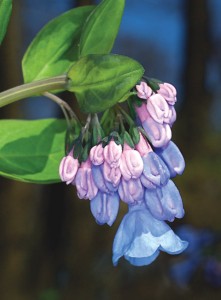Virginia Bluebells: A Chameleon-Like Plant
Posted in Science on May 15 2013, by Carol Gracie
After spending nearly three decades at the NYBG, and working much of that time in South American rainforests with her husband, Scott A. Mori, Carol Gracie has returned to one of her first botanical interests–local wildflowers. She is the author of Spring Wildflowers of the Northeast: A Natural History and coauthor (with Steve Clemants) of Wildflowers in the Field and Forest: A Field Guide to the Northeastern United States.

The leaves of Virginia bluebell sprout each spring in such deep shades of purple that they are difficult to see against the dark soil. As the leaves mature, the purple coloration is gradually lost until they become a soft green. Flowers, too, undergo a color change, from pink in bud to a lovely shade of blue shortly before the buds open.
The floral color change is not uncommon in members of this family, the Boraginaceae (borage family). Its members include forget-me-not (Myosotis spp.), viper’s bugloss (Echium vulgare), and lungwort (Pulmonaria spp.), all of which have pink buds opening as blue flowers. The color change is due to changes in the pH of the cell sap, and, like some hydrangeas, plants growing in more acidic soils will have flowers of a deeper shade of blue. Members of the borage family also share in common the shape of their inflorescence, referred to as a scorpioid cyme for the way it uncoils like a scorpion’s tail. A true spring ephemeral, the leaves of Virginia bluebells turn yellow soon after the flowers have finished blooming and are gone by late June.
